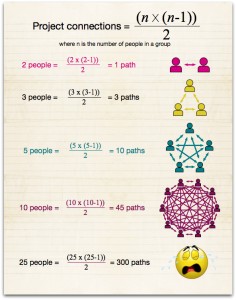Further to my rambling yesterday about project communications, I mentioned that as a project becomes more complex, the number of people who need to be kept in the loop increases.
Here’s the problem with that: each person added to a project exponentially increases the number of possible communications paths needed to keep everybody up-to-date on the latest bits of knowledge. Students of project management are familiar with the formula.
As you can see in my crappy picture above (which took me a long time to make so kudos are welcome), it doesn’t take very long at all before the number of possible communications channels becomes completely unwieldy! A project manager can easily run down the hall and bang on one door, or three doors…but at a certain point the blisters from all that running are going to make the exercise pretty pointless.
At the end of the day, the project manager’s job is to get the project done. That means, like it or not, they’re responsible for keeping those communication channels open, humming, and obstruction-free…without turning every workday into an eight-hour meeting!
So how do you do that when your project office is stacked waist high with human bodies?
1) Centralize communications. It used to be a project manager had to run from place to place trying to stay on top of all the information surrounding a project. That was extremely taxing and it simply meant work couldn’t get done very efficiently because the project manager was the bottleneck. Nowadays, we have a ton of online tools at our disposal that make communications fast and easy.
Setting up a project wiki is a great help because it gives all project members one place where they can go to stay up-to-date on project information. A well organized wiki might have some or all of the following features (or more!):
Reference Material:
- a calendar of milestones and important dates on the project
- an up-to-date contact list for everyone on the team
- the jobs and responsibilities for everyone on the team (maybe with an org chart!)
- a history of all the decisions that were reached
- an archive of meeting minutes
- an archive of signed-off documents
- self-serve background reading
Collaborative Section:
- discussion threads on decisions that are under review
- documents that people are working on, that can be discussed and/or annotated
- a place to raise, discuss and resolve issues
- a place to put out new ideas or talk about project risks
Reporting and Measurements Section:
- a place where managers can see summaries of what’s happening
2) Delegate communications. As you can see in the above diagram, it’s a lot easier to deal with 2 other people than 9 other people. Take 2 other people and make them responsible for two-way communications between a smaller group of people, and insist they provide you regular updates of what’s happening.
3) Organize communications. The larger the group, the more formal communications needs to be to make sure a) nothing slips through the cracks and b) people aren’t doing work based on wrong information. Cluster your team into groups (see yesterday’s Tech Republic diagram), and schedule regular meetings with a set agenda into that group’s calendar for the duration of the project. The agenda should map to the communication needs of that group, that is, some people will want more detailed information and some will want summaries. The more routine and “same” you can keep your communications, the less administration work you have to do, which should save you time in the long run.
Even following the above tips, you’ll still have your moments of running down the hall, but hopefully you’ll put a lot less wear on your shoes!

